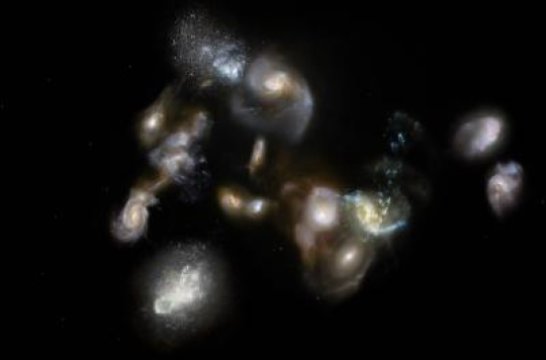For the first time, astronomers have witnessed the birth of a colossal cluster of galaxies. Their observations reveal at least 14 galaxies packed into an area only four times the diameter of the Milky Way's galactic disk. Computer simulations of the galaxies predict that over time the cluster will assemble into one of the most massive structures in the modern universe, the astronomers report in Nature.
Galaxies within the cluster are churning out stars at an incredible pace, ranging from 50 to 1,000 times the Milky Way's star formation rate. These rates are higher than can be explained for solitary galaxies, suggesting that the galaxies are influencing one another and are actively assembling into a cluster.
Galaxy clusters are the largest structures held together by gravity in the present-day universe and contain hundreds or even thousands of galaxies. Clusters grow over time as gravity draws in more material. This newborn galaxy cluster, or protocluster, is around 12.4 billion light-years away from Earth. That distance means that the protocluster appears today as it existed 1.4 billion years after the Big Bang.
Researchers spotted the protocluster during a follow-up to a survey conducted using the South Pole Telescope in Antarctica. That undertaking inspected around 6 percent of the sky, but with relatively coarse resolution. In those observations, the protocluster was the brightest light source not magnified by the effect of a massive object's gravity, which bends light like a lens. While bright, the source just looked like a fuzzy blob composed of at least three galaxies. An additional study by the Atacama Large Millimeter/submillimeter Array in Chile provided clarity and a surprise.
In total, the protocluster contains around 10 trillion suns' worth of mass. All that material in such a confined space means that the galaxies will probably merge over time, rather than drift apart.
Over that time span, the 14 galaxies will merge into one giant elliptical galaxy surrounded by a halo of galaxies, stars and dust. The researchers estimate that in the modern-day universe, the cluster will contain roughly 1,000 trillion suns' worth of mass. That's comparable to the mass of the Coma cluster of galaxies that lies a few hundred million light-years from Earth.
The surprisingly high star formation rates within the galaxies provide further evidence that the galaxies are forming a cluster.
The protocluster is a precursor to the larger and more mature galaxy clusters seen in the modern universe, making the protocluster an excellent test bed for learning more about how present-day clusters formed and evolved. Modern clusters, for instance, brim with superheated gas that can reach temperatures of more than 1 million degrees. Scientists aren't sure how that gas got there, though. The high rate of star formation in the newly discovered protocluster may provide a clue: A deluge of newborn stars in a forming cluster may spew hot gas into the voids between the galaxies. That expelled gas is not dense enough to form stars and instead lingers throughout the cluster.
